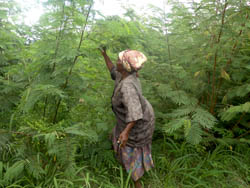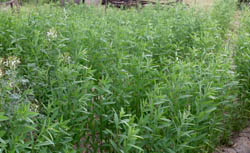Forage legumes are an affordable alternative feed for dairy livestock for the cash constrained smallholder farmers in Zimbabwe. Local pastures are usually inadequate for livestock especially during the dry season. The grazing quality of the native pastures also depends on the species composition of most pastures where most farmers graze their cattle. Sporobolus pyramidalis is a dominant species in Zimbabwe‘s pastures and has been classified as the worst in terms of feed quality for livestock. There is need therefore to supplement; protein rich concentrates are often unavailable and unaffordable for most smallholder farmers leaving protein rich forage legumes as the next viable option.
Numerous efforts have been directed at improving rangelands in Zimbabwe but the output has not been worth the effort owing to various reasons. Seedling survival during establishment, high cost of seed, poor targeting as well as lack of knowledge of most farmers on the importance and use of forages hampered adoption and frustrated most intervention efforts. For the N2Africa project, the target farmers for forage legume research and dissemination are those farmers that belong to dairy associations and are looking to improve their daily milk production. Three dairy associations are involved; the Chikwaka dairy association, Hwedza dairy association and the Guruve dairy association. Mudzi has also been selected to evaluate the adaptability of the various species because of its unique climatic environment although no functional dairy association is operating in the area at the moment.
Initiatives by some non-governmental organization in Chikwaka and Hwedza (Land o’ Lakes) has seen an attempt by most dairy farmers to establish their own forage and fodder banks. Farmers with established tree forages usually have a higher daily amount of milk sales to the dairy association compared to those who have no additional feed to their cattle. This has presented a good entry point for the N2Africa project. While the benefits of using tree forages has been fully understood among a selected group of dairy farmers, accessing the different species and establishing them has been the major challenge. As a result, apart from research trials on tree legumes and annual legumes, The N2Africa project availed different tree legume species to farmers for them to establish their own fodder banks. While there could be many other challenges associated with adoption of legume forages in smallholder farms, proper targeting alone presents a big opportunity and potential for adoption.
|
Dairy farmer Erica Mhonda-Mapango in Chikwaka harvesting biomass from Acacia and Leucaena species to feed her dairy cattle |
Crotalaria juncea in a farmers field in Chikwaka |
The tree species that are being evaluated in Zimbabwe are Acacia angustissima, Cajanus cajan (pigeonpea), Gliricidia sepium, Leucaena esculenta, L. leucocephala, L. pallida and L.trichandra. The growth of these species will be evaluated over the two years. For the annual species velvet bean (Mucuna pruriens var. utilis), trailing cowpea (Vigna unguiculata), lablab (Lablab purpureus), sunnhemp (Crotalaria juncea), sunnhemp (C.ochroleuca), forage soyabean (Glycine max; promiscuous, likely derivative of Hernon 147) will be tested.
Biomass production, BNF, pests and disease resistance, yield of a following maize crop, persistence, feed quality and grain yield will be measured as part of an evaluation in every agro-ecological zone. Chikwaka is in natural region 1, while Hwedza and Mudzi are in natural regions 3 and 4 respectively. The different species are being tested with and without fertilisers and the trees are being tested with and without the inoculant.
Overall, the forages have been very well received by dairy farmers and they hope to continue getting support and backstopping as this helps put money in their pockets after milk sales every day. Chances of adoption are high as farmers hope to benefit even in getting firewood from tree forages as well as contribute in putting nitrogen fixation to work for smallholder farmers in Zimbabwe!
Talkmore Mombeyarara


